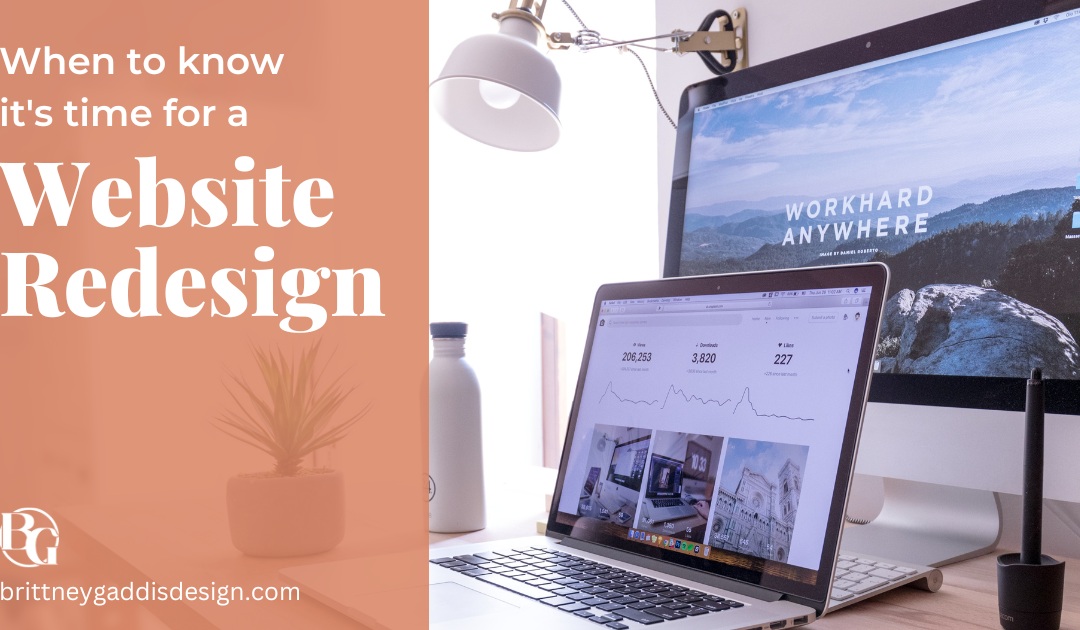Introduction
How do you know if it’s time for a website redesign? In today’s digital age, having a website is crucial for any business. It is one of the primary methods of converting visitors into leads. A business website typically provides consumers with information about its products, services, location, and more, in an easily accessible manner. It’s your online storefront and the first point of contact for potential customers.
Your website should answer the most common frequently asked questions that people might have about your business. Therefore, it should be your best salesperson. However, just having a website is not enough. It is vital to regularly review and update it to ensure that it meets the needs of your business and your customers.
As a general rule, you should update your business website approximately every 2-3 years. This article will explore some key reasons why redesigning your business website can be beneficial and how it can help to improve your online presence and drive success for your business. So, let’s dive in!
Determine why your website is not meeting your goals
If your website is not effectively converting visitors into leads or customers, it may be time to reconsider the design and functionality of your site. For any serious business owner, it is essential to optimize your website in order to maximize your profits. However, money alone is not the only driving force that helps determine if and when a website needs to be updated. There are several additional signs that it may be time to redesign your business website. Let’s review some key indicators to consider.
You’ve gone through a rebrand.
Your website and all marketing materials should look and feel consistent. If you have undergone a rebranding process, it’s critical for your website to accurately reflect your new brand identity, values, and message. This includes updating your logo, color scheme, and overall website design to align with your new branding. When your website has different buttons, colors, logos, etc on different pages, it could confuse users. Visitors may think your website is malicious, and not trustworthy. They are less likely to make a purchase or sign up with their email address.
Make sure typography, colors, imagery, buttons, and menus are all cohesive. Your website design should be in-line with your Brand Guidelines provided to you by your Logo Designer. If your website does not accurately reflect your brand identity, values, and message, it may be time to redesign it to better align with your brand.
After rebranding, you may have a new target audience or market positioning. It’s critical for your website to effectively communicate this new positioning and speak to the needs and interests of your target audience.
It appears outdated.
If your website looks outdated, it can turn off visitors and make your business appear less professional. That is why a company must redesign its website if it appears outdated. A website that looks like it was designed a decade ago will scare away potential users and make your business not feel trustworthy. Your potential customer will choose a competitor to give their business to. In contrast, a visually appealing website can help attract and retain visitors and improve your brand image.
You want to add new functionality.
Sometimes, goals and plans change, and it’s time to add new functionality to your website. Many businesses start with a simple landing page at the launch of their business. After the direction of their business is ironed- out, many business owners like to revisit their website and add new functionality. A website redesign can help ensure that the user experience on the site is pleasant and easy to navigate. These changes help your customers find what they are looking for. These improvements increase the chances that website leads convert to sales.
For example, a restaurant may start with a landing page, then a few years later decide that they would like to integrate an online ordering and delivery system into their website. After a few years, it is important to re-evaluate and redesign the site to make sure everything runs smoothly and efficiently as possible.
Another example may be a florist who started with a landing page, then, in a few years, wants to integrate paid tutorials for their customers to make flower arrangements at home.
There are several types of functionality that a business may want to consider adding to its website to keep it modern and up-to-date with current website development practices. Some examples include:
- Responsive design: Ensuring that your website is responsive or able to adapt to different screen sizes and devices is essential in today’s digital landscape.
- Content management system (CMS): A CMS allows you to easily update and manage the content on your website without the need for technical expertise.
- E-commerce capabilities: If you sell products or services online, you will need an e-commerce platform to handle all the transactions.
- Social media integration: Connecting your website to your social media accounts can help to drive traffic and engagement.
- Search engine optimization (SEO): Implementing SEO best practices can help improve the visibility of your website in search engine results.
- Analytics tracking: Adding analytics tracking to your website can help you understand how visitors interact with your site and identify areas for improvement.
- Improved security: Outdated technologies do not have the same level of security as newer technologies, making your website more vulnerable to cyber-attacks. A redesign using updated security measures can help to protect your website and your users’ information.
Overall, there are many different types of website functionality that a business may want to consider. It’s critical to regularly assess your website’s needs and consider what updates and improvements should be made to enhance its performance.
Your website is not responsive.
Non-responsive websites appear old and dated, making your business lose its credibility with users. This will negatively impact your bottom line. If your website is not responsive, it will not display properly on mobile devices, which can be frustrating for users and may cause them to leave your site.
Currently, most users view websites on mobile devices (according to Research.com, 53% of users used mobile devices to browse the web in 2019). These users expect a seamless experience across all platforms: desktop, tablet, and phone. If your website is not functional and easy to use on mobile, it will directly hurt your sales.
Search engines penalize websites for not being compliant with this. With the increasing prevalence of smartphones and tablets, your website needs to be easily accessible and legible on a variety of devices. If your website is not mobile-friendly, it’s time to consider a website redesign.
Your website is hard to update.
If your website is not regularly updated with fresh content, it can become stale and may not effectively engage visitors. It takes too long to send updates to developers and wait for them to update. It also unnecessarily adds extra cost. A website redesign that includes a content management system (CMS) can make it easier for you to update content on your site.
Modern websites are simple to update and do not require long waiting periods. Therefore, if updating your website content is too confusing, it’s time for a new site. If your integrations and plugins are no longer working or are not automatically updated, it’s time for a new website.
Your website no longer accurately reflects your offerings or services.
If your website reflects an old business model, it’s time to update. When it does not accurately reflect the products and services you are now offering, it can confuse visitors and may not effectively showcase your business. All products and services should be displayed clearly and should be easy to find on your site (meaning reflected on the home page, in the menu, and on applicable subpages).
Adding a subpage buried deep inside your website is not sufficient. The change should be reflected throughout all of your content. Customers may choose a competitor because they are unaware that you offer the product or service they want or need.
A redesign can help to ensure that your website accurately reflects all the products and services you offer and effectively communicates your message to your target audience. Remember to update all social media with the changes once your redesign is live (for cohesion across all web items).
Your website is built on outdated technology.
If your website is built on outdated technology, it may not perform as well as it could, leading to slower loading times and a poorer user experience. A redesign using more modern technologies can help improve the performance of your website.
As much as I would love to help make updates on a dated website, the truth is that it’s not a good idea. If your website is still using ancient technology like flash, using a theme that is no longer updated, running on old versions of PHP, or has compatibility issues with plugins that are no longer updated, it’s beyond time for a redesign.
Do not skimp and continue trying to update your dated site. I promise you it will cost you more money in the long run. Trying to duct-tape everything together will only lead to undesirable results.
Your website is not user-friendly.
If your website is hard to navigate, it can be frustrating for visitors and may cause them to leave your website. A redesign that includes a clear and intuitive navigation structure can help to improve the user experience and make it easier for visitors to find the information they need.
Also, If your website is not visually appealing, it may be less engaging for visitors and may not effectively showcase your business. A redesign that includes a more visually appealing design can help to improve the user experience and make your website more engaging.
Conclusion
Redesigning your business website can bring several benefits to your company. It can help to improve the user experience, increase mobile accessibility, and modernize the look and feel of your website. A website redesign can also help align your online presence with your brand identity, values, and message. Ultimately this can drive more leads and sales for your business. While redesigning a website can be a time-consuming and potentially costly process, the long-term benefits make it a worthwhile investment. So, if you are considering a redesign for your business website, do not hesitate to take the time to assess your current site and determine what changes are needed to improve its performance and effectiveness.
Remember, as a general rule of thumb, update your website design every 2 to 3 years. If you are experiencing any of the issues mentioned in this article or want professional and award-winning assistance to make your website perform to its highest potential, contact me at Brittney Gaddis Design. It will be a pleasure showing you how a full-service web design can provide you with the credibility and performance that you should come to expect from an expertly designed online presence.



Recent Comments